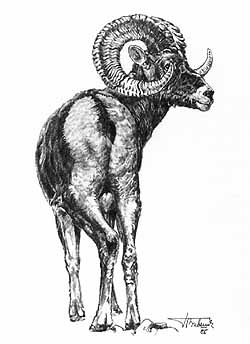English: Dall’s Sheep; French: Mouflon de Dall.
 |
| Ovis d. stonei |
Former distribution: As now.
Present distribution: From Alaska south to British Columbia; Brooks Range, Alaska Range, Lake Clarke to the Canadian border, Wrangell Mountains, the Chugach Range, the Talkeetna Mountains, Kenai Mountains, north and east of Fairbanks in the White Mountains and Tanan Hills in Canada, the Yukon Territory, to the south into northern British Columbia; the British, Richardson Warnecke and Ogilvie Mountains. In NW Territories in the MacKenzie Mountains.
Behaviour: Preferred habitat: alpine grasslands above the timber line at altitudes of about 600-2500 m; gregarious and form herds of between 6 and 25, occasionally up to 50 and more: activity mainly diurnal; diet includes grasses, low shrubs, willow, lichens and mosses; primarily grazers, but also browse; licks are used. Predators include wolves, bears, lynxes, wolverines, coyotes and eagles. Dall’s Sheep migrate from summer to winter ranges and back.
Population status: Estimated numbers 1980: Alaska: 30 000-50 000; Yukon: 18 000; NW-Territories: 3-8000; British Columbia: 200; Stone Sheep Ovis d. stonei: Yukon Territory: 4500; British Columbia: 9000-15 000.
Brief notes:
Body weight: 100-120 kg
Head and body length: 135-155 cm
Tail length-10-15 cm
Shoulder height: 95-105 cm
Gestation period: 171 days
Maximum age: 16 years
Trophy: Record SCI (Ovis d. dalli): 191 3/8 score, 1984, Alaska, SHERVIN N. SCOTT; average 150 score. B&B: 189 6/8 score, 1961, Alaska.
Hunting methods: Stalking.
Subspecies: 2
1. Dall’s Sheep Ovis d. dalli Alaska, Yukon Territory, northern British Columbia. Stable.
2. Stone’s Sheep: Ovis d. stonei Southern Yukon Territory, northern British Columbia. Stable. Trophy: Record SCI: 182 2/8 score, 1981. British Columbia, Romeo Leduc; average: 150 score. B&C: 196 6/8 score, 1936 British Columbia, L.S. CHADWICK; average 170 score.
Remarks: Dall’s and Stone’s Sheep are sometimes killed by avalanches, but losses caused by predators are much heavier. Management in Alaska and Canada is efficient, but it is suggested that old female sheep should be culled, and not only mature rams as at present – which will cause problems for the future social structure of the sheep population. Plans to increase domestic livestock into sheep areas would be dangerous for this species in Alaska. It would increase the competition for the grazing, and also bring livestock diseases into the sheep population. In Canada sheep areas are already faced with loss of habitat; therefore habitat protection, by law, is suggested.







